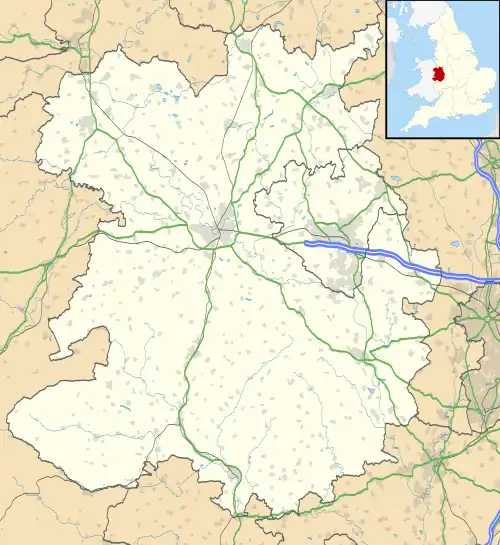| Newport House | |
|---|---|
 Newport House | |
| Location | Dogpole, Shrewsbury |
| Coordinates | 52°42′27″N 2°45′04″W / 52.7076°N 2.7510°W |
| Built | 1696 |
Listed Building – Grade II* | |
| Designated | 17 November 1995 |
| Reference no. | 1270999 |
 Shown in Shropshire | |
Newport House, formerly the Guildhall, is a former municipal building in Dogpole, Shrewsbury, England. It is a Grade II* listed building.[1] The boundary wall is separately listed.[2]
History
The site on which the current building stands had previously been occupied by a 16th-century mansion known as Castle Gates House, which was dismantled and moved to a new location near Shrewsbury Castle.[1][3] The current building, which was designed for Francis Newport, 1st Earl of Bradford, was completed in 1696.[1] A porch with the Doric columns was added in the 19th century.[1] Newport's grandson, Henry Newport, the 3rd Earl, leased it to Anne Smyth who became the mistress of William Pulteney, 1st Earl of Bath.[4]
The house was then passed down through the Pulteney family until it was inherited by William Pulteney who lived in it for a few years in the early 19th century, when he was serving as the local member of parliament.[4] In 1810 Earl of Darlington successfully laid claim to the Pulteney Estate after the Countess of Bath died intestate in 1808.[5] Newport House was then bought by William Hazledine, a Coleham ironmaster in 1821 and subsequently acquired by a Mr John Hughes in the 1840s.[4] In the late 19th century it served as the home of Edward Burd, a surgeon at the Salop Infirmary.[4][6]
In 1917 Newport House was acquired by the municipal borough of Shrewsbury, which had previously used part of the Shire Hall in the Market Square as its meeting place.[7] The building continued to be the local seat of government after the enlarged Shrewsbury and Atcham Borough Council was formed in 1974[8] until the council decided to move to modern facilities at Frankwell Quay in Frankwell in 2004.[9] The opportunity was taken at the time to carry out an archaeological survey which identified a sherd dating back to the late Saxon era.[10] Newport House was subsequently converted back for residential use as a family home.[11]
See also
References
- 1 2 3 4 Historic England. "The Guildhall, Shrewsbury (1270999)". National Heritage List for England. Retrieved 14 July 2020.
- ↑ Historic England. "Boundary wall to the Guildhall (1270834)". National Heritage List for England. Retrieved 14 July 2020.
- ↑ "The Next History Lesson From Martin The Town Crier". Love Shrewsbury. Retrieved 14 July 2020.
- 1 2 3 4 "Newport House (the Old Guildhall), Dogpole, Shrewsbury". Shropshire History. Retrieved 14 July 2020.
- ↑ Baggs, A P; Bolton, Diane K; Hicks, M A; Pugh, R B (1980). "'Hornsey, including Highgate: Other estates', in A History of the County of Middlesex: Volume 6, Friern Barnet, Finchley, Hornsey With Highgate". London: British History Online. pp. 146–149. Retrieved 14 July 2020.
- ↑ "List of Members". Shropshire Archaeological and Natural History Society. 1907. Retrieved 14 July 2020.
- ↑ Pidgeon, Henry (1837). Memorials of Shrewsbury: being a concise description of the town and its environs. p. 116.
Old Shire Hall Shrewsbury Robert Smirke 1837.
- ↑ The Macmillan Guide to the United Kingdom 1978-79. Palgrave Macmillan. 1978. ISBN 978-1349815111.
- ↑ "Shrewsbury Guildhall transformed into seat of learning for university". Shropshire Star. 14 October 2015. Retrieved 14 July 2020.
- ↑ Kenney, J.; Wainwright, J. (2004). "The Guildhall, Dogpole, Shrewsbury. A Report on an Archaeological Evaluation". Marches Archaeology. Retrieved 14 July 2020.
- ↑ "Newport House, Shrewsbury". Morris & Co. Retrieved 14 July 2020.